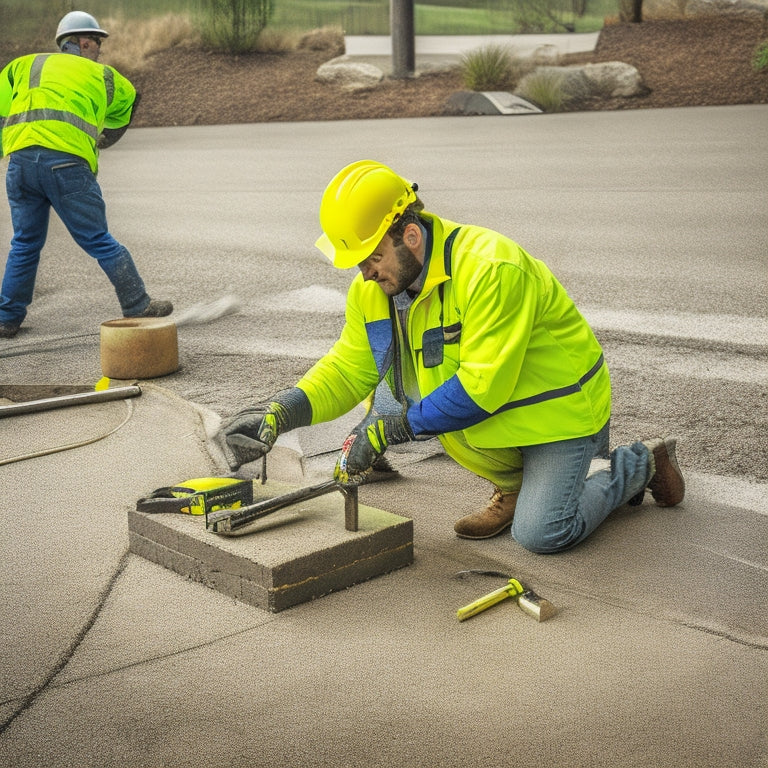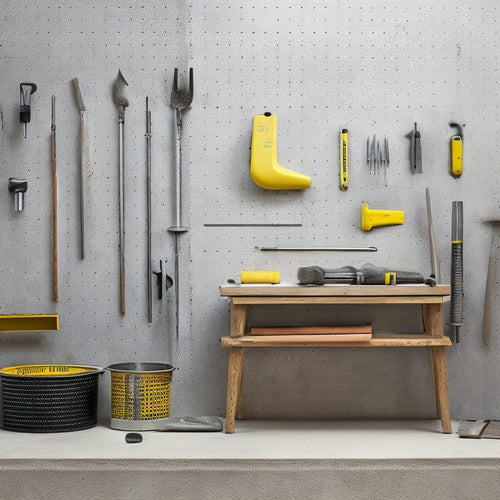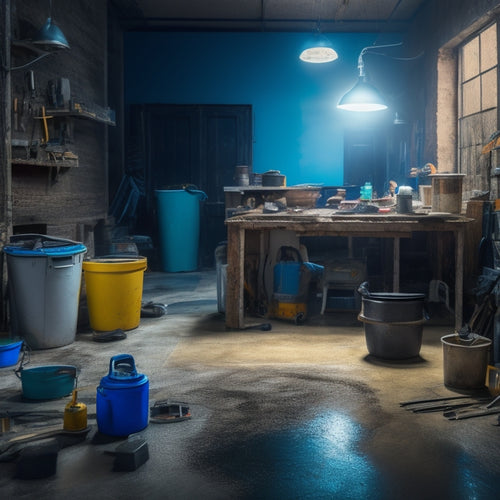
Top Tools for Profiling Stamped Concrete Surfaces
Share
When profiling stamped concrete surfaces, you'll need a variety of tools to achieve a high-quality finish. Must-haves include a concrete profiling edger, profiling hammer, profiling rake, and dustless profiling grinder for surface preparation and refinement. For advanced texturing and refining, add skin pattern rollers, texture mats, and precision tamping tools to your arsenal. Specialty tools like pattern stamps and texture rollers will help you create intricate designs, while edging and detailing tools like edger tools and detailing brushes will perfect your work. With these top tools, you'll be well-equipped to tackle complex stamped concrete projects - and there's still more to discover.
Key Takeaways
• Essential profiling tools, including edgers, hammers, rakes, and grinders, create clean edges and refine the concrete surface for stamping.
• Advanced texturing and refining tools, like skin pattern rollers and texture mats, replicate natural materials and ensure crisp textures.
• Specialty tools, such as pattern stamps and texture rollers, create realistic patterns and add depth to stamped concrete surfaces.
• Edging and detailing tools, including edger tools and detailing brushes, craft precise angles and add subtle texture and depth to designs.
• Power tools, like angle grinders and floor grinders, efficiently remove old coatings, roughen surfaces, and expose aggregate for a professional finish.
Essential Profiling Tools for Stamped Concrete
You'll need a combination of essential profiling tools to achieve a high-quality, textured finish on your stamped concrete surfaces. These tools will help you master various profiling techniques, ensuring a flawless surface preparation.
First, you'll require a concrete profiling edger, which is designed to create clean edges and definition around corners, joints, and patterns.
A profiling hammer is another must-have, as it helps to break down and refine the concrete surface, allowing for a more even texture.
Additionally, a profiling rake is necessary for removing excess material and creating a uniform surface.
Don't forget a dustless profiling grinder, which is perfect for refining and polishing the surface, leaving it ready for stamping.
Advanced Texturing and Refining Tools
With advanced texturing and refining tools, you can take your stamped concrete surfaces to the next level, achieving intricate patterns and textures that mimic natural materials with uncanny realism.
These cutting-edge tools enable you to create complex, high-definition designs that elevate your concrete work from ordinary to extraordinary.
Advanced texturing innovations, such as skin pattern rollers and texture mats, allow you to replicate the subtle nuances of natural materials like stone, wood, and slate.
Refining techniques, like precision tamping and floatation, guarantee that your textures are crisp, clean, and free of imperfections.
By combining these advanced tools and techniques, you can achieve an unprecedented level of realism and detail in your stamped concrete surfaces.
To master the art of advanced texturing and refining, it's crucial to practice and experiment with different tools and techniques.
Start by investing in high-quality texturing and refining tools, and then hone your skills through hands-on practice and experimentation.
With patience, dedication, and the right tools, you'll be able to create stamped concrete surfaces that rival the beauty and complexity of natural materials.
Specialty Tools for Pattern Creation
Specialty tools, such as pattern stamps and texture skins, enable you to create intricate, high-definition patterns on your stamped concrete surfaces, allowing for unparalleled design flexibility and customization.
These tools are designed to produce specific patterns, textures, and designs that can elevate your projects from ordinary to extraordinary. With pattern stamps, you can achieve realistic stone, wood, or brick patterns that mimic the real thing.
Texture skins, on the other hand, provide a more subtle, organic look. You can also use texture rollers to add depth and visual interest to your designs. By combining these tools, you can create complex, multi-layered patterns that showcase your creativity and expertise.
When selecting specialty tools, consider the specific design elements you want to achieve and choose tools that will help you realize those results.
With practice and experimentation, you'll be able to reveal the full potential of these tools and take your stamped concrete projects to new heights.
Edging and Detailing Tools for Perfection
To achieve a polished, professional finish, you need to focus on the edges and details of your stamped concrete surfaces, where edging and detailing tools come into play. These tools allow you to refine your edging techniques, creating crisp, clean lines that define the pattern and add visual appeal.
For instance, you can use an edger tool to create a 45-degree angle along the edges, giving your design a sleek, modern look.
When it comes to detailing finishes, the right tools can make all the difference. You'll want to invest in a set of detailing brushes, which enable you to add subtle texture and depth to your design.
These brushes come in various sizes and shapes, allowing you to precision-craft intricate details, such as veins in a stone pattern or texture in a wood-grain design.
Power Tools for Efficient Profiling
You'll rely on a range of power tools to efficiently profile your stamped concrete surfaces, ensuring a consistent, high-quality finish. These tools are essential for surface preparation, allowing you to achieve the desired texture and pattern.
When it comes to grinding techniques, angle grinders and rotary hammers are your go-to tools. They enable you to remove old coatings, roughen the surface, and create a strong bond between the concrete and the new overlay.
For more aggressive grinding, you'll need a floor grinder or a scarifier. These machines are designed to remove thick layers of old coatings, epoxy, or other stubborn substances. They're also effective for exposing aggregate and creating a textured surface.
When working with smaller areas or tight spaces, consider using a right-angle grinder or a die grinder. These tools provide more precision and control, making them ideal for detailed work.
Frequently Asked Questions
How Often Should I Clean and Maintain My Profiling Tools?
You should clean your profiling tools daily to prevent material buildup and maintain their effectiveness.
Set a routine to inspect and clean your tools after each use, and perform a deeper clean weekly.
Regular maintenance tips include lubricating moving parts, sharpening worn edges, and storing tools in a dry place.
Can I Use Profiling Tools on Newly Poured Concrete Surfaces?
You can't use profiling tools on newly poured concrete surfaces just yet. Fresh concrete requires a curing period to achieve ideal strength and stability.
Premature profiling can compromise the concrete's integrity, leading to uneven surfaces and potential damage.
Wait until the concrete has cured, usually 24-48 hours depending on environmental conditions, before applying profiling techniques.
This guarantees a strong, even base for your stamped concrete design.
What Safety Precautions Should I Take When Profiling Stamped Concrete?
When profiling stamped concrete, you'll want to prioritize safety above all else. Start by donning personal protective equipment like gloves, safety glasses, and a dust mask to shield yourself from debris and dust.
Next, carefully select the right equipment for the job, guaranteeing it's in good working condition and suitable for the task at hand. Proper equipment selection will help prevent accidents and guarantee a successful profiling process.
How Do I Store Profiling Tools to Prevent Damage and Rust?
When storing profiling tools, you're fundamentally putting a prized sports car in a garage - you want to protect it from the elements.
Just as a car cover shields the paint from dust and UV rays, a dry, clean storage space with a rust-inhibiting coating will preserve your tools.
Store them in airtight containers or bags, and consider applying a rust preventative, like silicone spray or wax, to metal components.
This attention to detail will keep your tools in prime condition, ready for the next profiling project.
Are Profiling Tools Suitable for Use on Non-Stamped Concrete Surfaces?
When you're considering using profiling tools on non-stamped concrete surfaces, you'll want to assess the surface compatibility first. Not all profiling techniques are suitable for every surface type.
You'll need to evaluate the surface's texture, porosity, and hardness to determine the best approach. If the surface is too soft or delicate, some profiling tools may damage it.
But with the right tool and technique, you can achieve professional-looking results on a variety of non-stamped concrete surfaces.
Conclusion
You've now got the know-how to tackle stamped concrete projects with confidence.
With the right profiling tools, you can achieve professional-looking results.
Did you know that, according to the American Society of Concrete Contractors, the decorative concrete industry is projected to reach $14.3 billion by 2025?
With the tools and techniques outlined in this article, you'll be well-positioned to capitalize on this growing trend.
Related Posts
-

Must-Have Tools for Laying Concrete Tiles
When laying concrete tiles, you'll need a range of essential tools to get the job done right. Start with subfloor pre...
-

10 Must-Have Tools for Concrete Repair Organization
You'll need a solid organization system to keep your concrete repair tools and materials within easy reach, protected...
-

Essential Tools for Epoxy Concrete Floor Repair
You'll need a thorough arsenal of specialized tools to guarantee a successful epoxy concrete floor repair. Floor prep...


